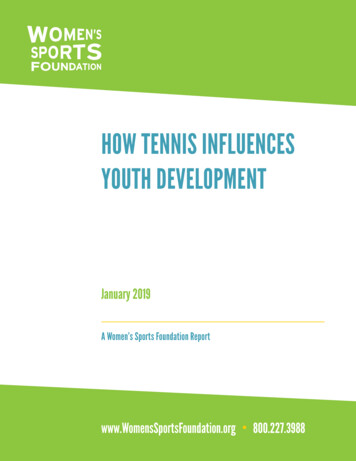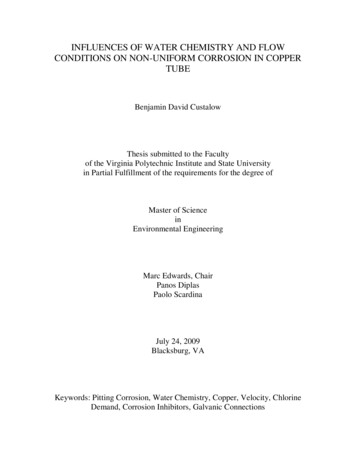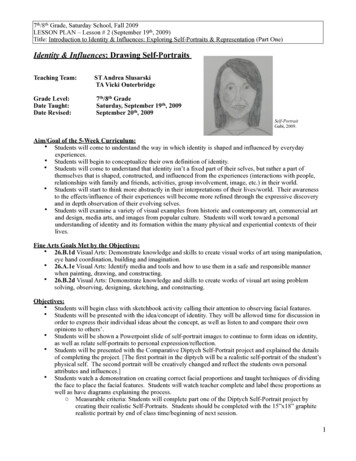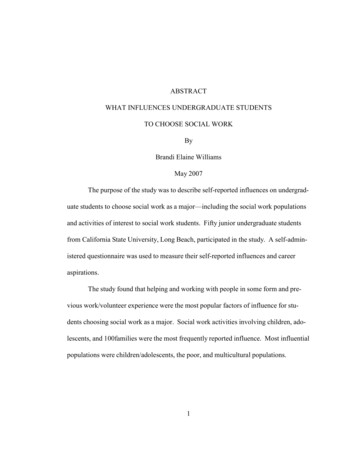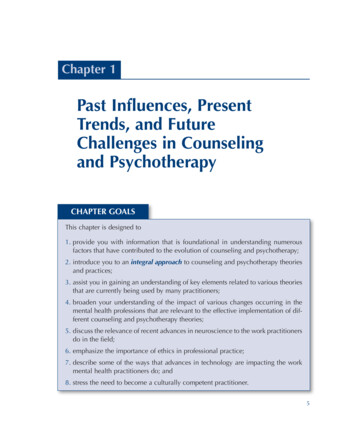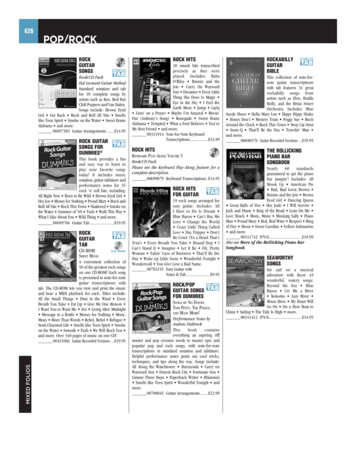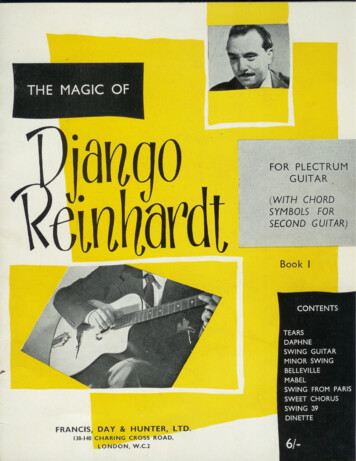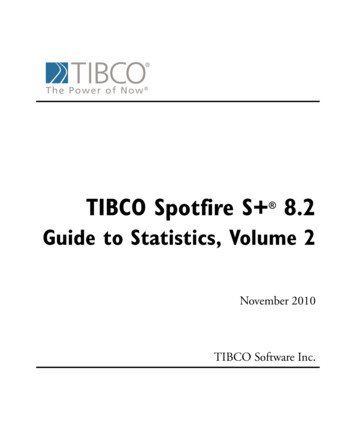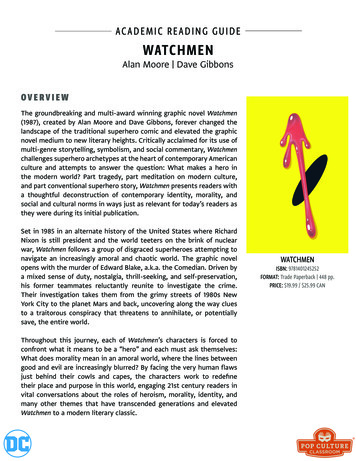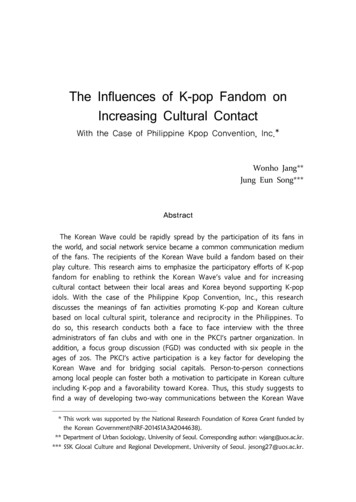
Transcription
The Influences of K-pop Fandom onIncreasing Cultural ContactWith the Case of Philippine Kpop Convention, Inc.*1)2)3)Wonho Jang**Jung Eun Song***AbstractThe Korean Wave could be rapidly spread by the participation of its fans inthe world, and social network service became a common communication mediumof the fans. The recipients of the Korean Wave build a fandom based on theirplay culture. This research aims to emphasize the participatory efforts of K-popfandom for enabling to rethink the Korean Wave’s value and for increasingcultural contact between their local areas and Korea beyond supporting K-popidols. With the case of the Philippine Kpop Convention, Inc., this researchdiscusses the meanings of fan activities promoting K-pop and Korean culturebased on local cultural spirit, tolerance and reciprocity in the Philippines. Todo so, this research conducts both a face to face interview with the threeadministrators of fan clubs and with one in the PKCI’s partner organization. Inaddition, a focus group discussion (FGD) was conducted with six people in theages of 20s. The PKCI’s active participation is a key factor for developing theKorean Wave and for bridging social capitals. Person-to-person connectionsamong local people can foster both a motivation to participate in Korean cultureincluding K-pop and a favorability toward Korea. Thus, this study suggests tofind a way of developing two-way communications between the Korean Wave*** This work was supported by the National Research Foundation of Korea Grant funded bythe Korean Government(NRF-2014S1A3A2044638).** Department of Urban Sociology, University of Seoul. Corresponding author: wjang@uos.ac.kr.*** SSK Glocal Culture and Regional Development, University of Seoul. jesong27@uos.ac.kr.
30 Korean Regional Sociologyreceivers and Korean cultural industries.Key words: Cultural contact, Participatory culture, Fandom, K-pop, PhilippinesIntroductionThe Korean Wave provides a meaningful opportunity for Korean governmentto take advantage of newly emerging cultural and public diplomacy to promoteKorean cultural assets (Jang and Paik, 2012: 201). In general, the highlypopular works contributing for the spread of the Korean Wave areentertainment-oriented genres, such as Korean dramas, K-pops, and Koreanfilms, although the Korean Wave has been defined in various ways. Thevariety of Korean Wave contents show the cultural diversity and richness ofKorea (Ha, 2017: 58). The Korean Wave receivers are likely to experience inKorean culture in order to fully understand the context of films, dramas, andK-pop. As a representative content of the Korean Wave, K-pop is understoodas a part of a global trend especially popular among youth (Jang et al., 2012:80).The Korean Wave may be spread rapidly by its active recipients and K-popfandom in general. The number of Korean Wave fans in the world has almostreached 60 million as a result of the syndrome of the Korean drama “TheDescendent of the Sun” in 2016. According to the “Global Korean Wave 2016”by the Korea Foundation, there are 1,652 Korean Wave communities consistingof 59,390,000 members in 88 countries. In the Asia and Pacific regions, thenumber of Korean Wave fans remarkably increased from 20,000,000 to40,100,000. In the region of the America, the popularity of K-pop contributesto the expansion of Korean Wave fan communities (Star Today, Jan. 25, 2017).A fandom makes its own identity by showing differences and uniquenessto non-fans as well as by distinguishing itself from diverse fandoms. Previousfandom studies focused on commercial power, subculture, gender, and resistanceto irrational conditions regarding pop stars/idols. One of the characteristics
The Influences of K-pop Fandom on Increasing Cultural Contact 31among the Korean Wave fandoms is the use of new media. Social networkservices (SNS) have become a common communication medium among thefans across national boundaries. The Korean Wave fans actively participatedin expressing themselves, replying to other comments, and providing videocontents. Also, the fans uses SNS to communicate among fans in daily lives.K-pop fans in some regions express their desire and respect about howKorea has achieved its economic and cultural development; furthermore, thosefans anticipate the ‘Korean dream’ by following Korean culture. The fans notonly consume a variety of Korean Wave entertainment contents but alsoparticipate in Korean culture, such as through food, language, and traditionalevents. On the other hand, the negative effects of K-pop fandom are becomingobvious concerns as the popularity of the Korean Wave is increasing. SomeK-pop fans show aggressive collective activities for their chosen K-pop starson SNS.This research aims to emphasize the participatory behaviors of K-pop fansfor enabling to rethink the Korean Wave’s value and for increasing culturalcontacts based on the case of the Philippine Kpop Convention, Inc. Thisresearch explores the meanings of Filipino fan activities promoting K-popand Korean culture beyond supporting a given K-pop star. The fans’ activeparticipation is a key factor for the sustainability of the Korean Wave and forbridging social capitals. It will be further suggested to strengthen friendshipsbetween the Philippines and Korea by understanding the fans’ motivationsand behaviors.Theoretical BackgroundPeople in different countries received the Korean Wave depending on political,economic, socio-cultural factors in each country. The diverse responses to theKorean Wave in each country are related to individual interactions to valuesand experiences in plural time periods. For example, the meaning of consuming
32 Korean Regional SociologyKorean Wave products would be either advanced or low culture throughinteracting with a global cultural form (Ainslie et al., 2017: 65-66).Along with the spread of Korean Wave, however, it is also reported thatvarious anti-Korean Wave movements have emerged in Asian countries,especially in China and Japan where Korean Wave phenomena first emerged.Or, some of the Korean Wave content receivers lost interests due to the levelof dissatisfaction and tiredness with the Korean Wave contents and/or thebenefit-oriented strategies of the Korean Wave industry, such as increasingprices, the commercialization of products related to Korean Wave celebrities(Ainsile et al., 2017: 67-68; Kim et al., 2014: 6-7). Kim et al. (2014) discussedanti-Korean Wave attitudes in China, Japan, Thailand, Indonesia, and Singapore.The problems of Korean Wave products, such as unsatisfying contents andmarketing strategies, raise negative issues in the process of exchange (7). Althoughthe anti-Korean Wave attitudes actually appeared in Japan due to political issues,the possible reasons are summarized as: 1) general criticisms of Korea; 2) criticismof youth culture as subaltern culture; 3) misunderstandings and conflicts abouthistory; 4) criticism of the unilateral communication; and 5) expressions offear over the possibility of losing one’s own cultural characteristics. As asolution, the FGD participants in those countries concluded to increase mutualcultural exchanges with Korea (Han et al. and Lee quoted in Kim et al. 6-7).The Korean Wave and Nation Branding of KoreaKorean cultures shown at historical dramas and family dramas can be amedium of learning Korean culture based on the values, belief, and taste ofthe participants. The Korean Wave receivers consume the styles of the KoreanWave different from those of their local cultures according to the FGDresearch (Jang et al., 2012: 85-86). Thus, the theory of Cultural Discount wouldnot be enough to understand the growth of Korean Wave. Rather, the degreeof tolerance to accept cultural difference should be considered.
The Influences of K-pop Fandom on Increasing Cultural Contact 33The Korean Wave was meant as a competitive identity maker in order todevelop the image of Korea. The contents of popular K-pops and Koreandramas are frequently emphasized to express the spirit and values of Koreaand to promote the image of Korea. A nation’s image is a perception andopinion of others (foreigners) about a country based on familiarity and favorabilitythrough direct and indirect experiences. A nation’s commonly perceived imagecan be constructed by the cognitive, affective, and behavioral response ofothers. One’s cognitions include values, beliefs, knowledge, and experiences inhis/her society, such as “language, socialization practices, norms, roles, [and]laws” (Stephan, C. and Stephan, W. 128, quoted in Song, 2010: 43). These cognitiveaspects involve the process of analyzing and interpreting information. Theaffective dimension is about emotional response and attitude. Finally, both thecognitive and affective dimensions result in the behavior dimension, and alsothe combined response from both cognition and affect causes a resultingbehavior (Song, 2010: 43).A nation’s image is a projection of the nation’s perception of its ownidentity, in particular, of its culture and arts – heritage, landscape, and the arts,which Dinnie (2009) calls the “cultural expressiveness” of a nation (Dinnie 147;Song, 2010: 7). Culture is a resource for reaching others because of commonvalues and interests. Also, culture is a source of negative stereotypes andemotional responses. For example, many people in different countries enjoyAmerican music like rock and jazz music, and this is caused for them to feelfamiliar with or favorable to U.S. culture. People may also think about“freedom as a key value of democracy by enjoying rock and jazz music, andas a result they can build a positive image of the U.S.” (Song, 2010: 31).Similarly, the high level of favorability of the Korean Wave has resulted asthe increase of familiarity and favorability of Korean culture, such as thecharacter of a people, the common cultural heritage, the language, and theway of life of a people. A nation’s image does not simply induce highfavorability; it simultaneously results in a cause of behavioral changes, suchas relationship-building (Song, 2010: 197-198).
34 Korean Regional SociologyPopular culture fandom has been thought as an object of national culturalpolicy concerned with nation branding (Lee, 2016: 12). Nation branding, asstrengthening a nation’s soft power (Nye 2004, Fan 2008) increases the familiarityand favorability of the state by promoting its domestic cultural contents(Lee,2016: 12; Song, 2010: 43). Fan (2008) defines nation branding as “a cross-culturalcommunication process that very much resembles the advertising process:awareness-attraction-preference”, and as “a nation’s brand consists of threesub-brands: political brand, economic brand and cultural brand” (155). TheKorean Wave has a positive impact and potential that could promote Korea’ssoft power approach. For instance, Sung (2010) notes the Korean Wave providedan opportunity for Taiwan and Korea to build a positive relationship and hasprovided Taiwanese with a new image of South Korea. Moreover, the KoreanWave has promoted increasing cross-cultural ties (Jang and Paik, 2012: 197-198).The impact of popular dramas diffused South Korean culture to daily culturein foreign countries and invited the number of tourists who wanted toexperience traditional foods in South Korea. The ways of thinking and livingexpressed in Korean dramas influenced the viewers to increase consumptionof Korean foods and goods (Jang and Paik, 2012: 201).Korean public organizations, such as Korea Foundation(KF) and KoreaFoundation for International Cultural Exchange(KOFICE), have been dedicatedto spreading the Korean Wave contents and to supporting the Korean Wavefan clubs abroad. A fandom is understood as a target of nation brandingthrough the country’s popular culture. However, nation branding projects shouldnot treat popular culture fandom as just passionate consumers of domesticpopular cultural products without understanding the participatory culture offandom (Lee, 2016: 12). As a way of building a positive image and relationshipwith the Korean Wave fans, the Korean Wave industry should develop itsmanagement to listen to the fans’ voices and reflecting how both the fans andthe Korean Wave industry can develop sympathy (Ha, 2017: 59).
The Influences of K-pop Fandom on Increasing Cultural Contact 35The Korean Wave Fandom and Korean Culture PromotionA fandom can be both a big consumer of and a cooperator with culturalindustries. Usually, popular cultural industries are likely to see fandom as atarget group for making profits. Recently, active fandom participation hassuggested industries re-consider a fandom as a cooperator and managerbeyond the consumer role. In the case of the K-pop global fans, they areexpanding their participations from promoting their idols to managing aconcert that K-pop industry seldom offers due to low net profit.Fandoms not only promote their specific subjects but also actively consumethem by recreating the original subject with high levels of attachment. Popularculture fans consume a specific content, artist, and/or text of mass-producedpopular cultural contents in their daily lives. When the fans collect thespecific chosen subjects and share common cultural tastes with each other, thefans can build a fandom and kinship (Jeong 37). Popular culture fans expresstheir desires, values, and identity by consuming the subject, and they sometimesfollow whatever their chosen stars do. The fans are dedicated to producingtransformative and recreative contents, such as fan fiction, fan videos and toproviding subtitling or translation services to foreign texts. In addition, they“have become part-time collaborators with official producers seeking to inciteand retain dedicated fan audiences, and part-time co-opted word-of-mouthmarketers for beloved brands” (Hills, 2010: 58; Chin and Morimoto, 2013: 98).This results in the “curious co-existence of both anti-commercial ideologiesand commodity-completist practices” within fan cultures (Hills, 2002: 28; Chinand Morimoto, 2013: 98).Until recently, the collective behaviors and values of popular culture fanshave been regarded as unusual by the general public. Mostly, as Jenkins said,fans have been considered “cultural dopes” and as resistant to the socialsystem and cultural hegemony (Jeong 38). The prejudice towards the fans waschallenged after cultural studies rooted in England. The fans were ratherunderstood as active and independent participants with own abilities of
36 Korean Regional Sociologydecoding and recreating popular contents (Jeong, 2016: 39). The ‘audienceresearch’ considers a popular culture consumer as a social independent agent,not as a passive receiver of media contents. According to the ‘audienceresearch’ by Fiske (1992/2002), a variety of audiences in the world can builda new cultural community, an analytic community of popular culture (Jeong,2016: 40). This perspective made possible to conceptualize a mass mediareceiver and fan as a social independent agent.The cultural studies focuses on the characteristics of fans in terms ofproductivity and participation in producing transformative texts and accumulatingcultural capital like collecting objects and knowledge (Lee (2013) quoted in Jeong,2016: 41). As McMillan & Chavis (1986) said, a fandom as a community iskept based on belongingness and membership, reciprocal giving, influenceon controlling members’ private lives, reward and integration, interactivecommunication and feeling of bonding (quoted in Sohn, 2012: 52). Fansseldom produce and recreate works “purely for the sake of doing so or evenfor exclusively personal use; fans make these things for other fans to use”(Turk, 2014: 4.1). Thus, a fandom should be studied with economical andsocio-cultural characteristics. Attentions on both local contexts and globalconditions are kept for understanding a diversity of fandom.Fiske discussed the relations between fandoms and others (non-fan members).A fandom is discriminated itself from others who cannot agree with or feelabout what fandoms pursue for. In doing so, a fandom implies that a fandomis a productive and meaningful activity rather than unconditionally supportingpop stars. A fandom actually critically interprets its chosen stars and contents.According to Jenkins (1992), a fandom can be an alternative cultural communityfor cultural diversity in society. Then, Fiske saw that each fandom tries to bedistinct among various fandoms even when to support a same content or star(Jeong, 2016: 45).On the other hand, Hills (2002) suggested not to overly understand theresisting ability of fandoms with regards to productivity and cultural capitalaccumulation overestimated although fandoms show their participatory culture
The Influences of K-pop Fandom on Increasing Cultural Contact 37and make changes. Rather, according to Hills, a fandom consists of differenceand colorfulness, not bonding with similarities and common values, and afandom has been developing diverse subcultures (Jeong, 2016: 44). Whiledeveloping cultural capital and making differences, a fandom shows itsuniqueness through the results of the diverse identities of each fan. A fandomhas two-folded desires: it wants to be identified with its own characteristicsbut, at the same time, it seeks recognition and empathy for what it hasachieved.K-pop, as a part of global cultural content, has been building relations bybridging global (K-pop’s universal elements) and local K-pop fans. K-popfandoms have been establishing a transnational cultural community throughthe internet and mobile technology. Online community is a social place forthe people who share common interest and issues with online users andactively interact with each other. The feeling of solidarity among the peoplecan be developed. K-pop fans delivered the Korean Wave contents throughmostly YouTube, Facebook, and online fan pages in order to share thecontents with and to build cultural ties with the Korean Wave fans in localand global areas. They actively participate in expressing themselves, replyingto other comments, and providing video contents. The fans share informationand regularly organize events and community activities in regions throughYouTube, SNS, and so on. Their YouTube participation contributes to creatingtwo-way communication between the Korean Wave and its global fans byspreading and re-creating the Korean Wave contents, such as a K-pop coverdance. The spirits of openness, participation and sharing are similar to thecharacteristics of global fandom communicating through the web and mobilemedium.The Korean Wave fans engage in voluntary activities to elevate their star’simage. In Korea, the fans of the idol group ‘Shinhwa’ started donations in2007, and the philanthropic activities spread among the Korean Wave fans.The fans in different regions organize associations and social clubs to participatein sociocultural events such as fund-raising, donating to local/global charity,
38 Korean Regional Sociologyvolunteering in emergency situation, and so on. The philanthropic activitiesalso develop the fans’ own reputation. K-pop fans are likely to highly concerntheir own reputation and to create a “mature image via philanthropy” becausethey recognize that “their behavior reflects back onto the stars” (Koreaexpose,Feb. 20, 2017).However, the participatory activities of Korean Wave fans are not alwayspositive. The negative effects of Korean Wave fandoms are also becoming acritical issue as the popularity of the Korean Wave is increasing, in particularthat of K-pop. K-pop has different meanings among the Korean Wave fanswith a different degree of embrace by local cultures. An online K-pop fandomcan have a negative influence and/or struggles while K-pop fans fully use theinternet and SNS to support their stars. For example, the Billboard Awardis presented to the most popular pop music fandom annually. People mostlyexpect that either ‘One Direction’ or ‘Justin Bieber,’ ranked on the pop charts,would have the biggest and most powerful fandom due to their familiarity inthe global pop music market. However, the award was given to the K-popfandom of T-ara Queens. The Billboard Award’s fan-army-off competition isdivided into four sections by four music genres: pop, R & B / Hip-Hop,K-Pop, Rock. ‘Queens’, the name of ‘T-ara’ fandom, beat all of the competitorsin the K-pop section and won over the fandoms of ‘One Direction,’ ‘Beyonce’(R & B / Hip-Hop), ‘5 Seconds of Summer’ (Rock). Although the fandomsparticipating in the Billboard Award’s fan-army-off competition showed roughand harsh activities in order to win, ‘Queens’ was criticized for its highlyaggressive actions (billboard.com, Aug. 19, 2015). Cybervigilantism and otheringmechanisms are representative examples found among K-pop fans. Otheringmechanisms by the high level of online communications among the globalK-pop fans are resulted as conflictions, such as presenting “a strong sense ofnationalism and even racism.” K-pop idol group fandoms sometimes show“assertive and devoted” actions only for protecting the chosen idol groups ina collective manner (Jung, 2012: 3.1).
The Influences of K-pop Fandom on Increasing Cultural Contact 39Research MethodsThis research conducted both a focus group discussion (FGD) with theKorean Wave fans and a face to face interview and three rounds of emailinterviews with the members of Philippine Kpop Convention Inc. (PKCI) Inaddition, this research also observed the fan activities of the PKCI from itsFacebook page. This research uses Focus Group Discussion (FGD) method withexploratory and open-ended questions. FGD is one of the main qualitativeresearch methods and is designed to interpret the inherent motivations andreasons of research participants. The FGD was conducted in Manila, Philippinesfrom February 2015, and the six participants of the FGD research were in theages of 20s. The FGD research participants were recruited by each local partnerwithout any condition. The in-depth interview was conducted with the threeadministrators of the PKCI and the one active K-pop fan in its partnerorganization. Then, the two times of email interviews were followed with theinterviewees from September 2015 to December 2016. Table 1 and Table 2 showthe list of FGD participants and in-depth interviews in Manila, Philippines. Table 1 The List of FGD Participants in the age of 20sName(Initials)AgeOccupationSexBelonging to Fan Z20sStudentFemaleNoD.C.P.C20sStudentFemaleYes Table 2 The List of In-depth Interviewees in the PKCI and its partner g to Fan Free lancerFemaleNo
40 Korean Regional SociologyThe following three questions need to be addressed to explain theparticipatory culture of the PKCI and to develop a relationship between theK-pop fans and Korea- in particular, the Korean Wave industry and Koreangovernment organizations:1. How is K-pop received by local people including the Korean Wave fans?2. What types of activities of a foreign K-pop fandom contribute to increasingfamiliarity and favorability(branding) the Korean Wave and Korean culturein general?3. What are the roles of the PKCI in increasing cultural contact?DiscussionAccording to Lipura’s survey, 100 Filipinos regarded the characteristics ofKorean Wave as the cultural similarity, hybridity, dynamics and freshness.The survey participants considered the hybridity of the Korean Wave betweenAsian and Western cultures as strengths and felt the familiarity towardKoreans because of experiences with the Korean immigrants in Manila. Thepopularity of the Korean Wave makes an impact on the 5 areas: 1) respectto Others in both Korean and Philippine societies; 2) building a network andsocial capital; 3) increase of philanthropy and corporate social responsibilities;4) increase of trades and tours; and 5) cultural and educational exchanges(Lipura, 2014: 3).In 2005, Korean dramas were introduced through the local TV channels ofthe Philippines. K-pop could be spread rapidly due to the familiarity ofKorean dramas and the colorfulness of K-pop performances different from theoriginal music of the Philippines. The local people receive K-pop and Koreandrama independently by keeping local cultural spirit and taste, according tothe FGD participants. For example, some of cultural industries in theSoutheast Asia either copied or made boy and girl bands similar to K-pop boyand girl bands in order to achieve the economic and cultural effect shown in
The Influences of K-pop Fandom on Increasing Cultural Contact 41the case of the spread of the Korean Wave. Those glocalized boy and girlbands seem to be popular among local teenagers. Similarly, in the Philippines,some of local boy and girl bands were made very similar to K-pop idolgroups, such as 1:43pm, Pop Girl, XLR8. However, they could not earnpopularity. Local people regarded those groups as a failure of pinoy-popbecause those groups just copied the styles of K-pops rather than reflectingthe characteristics of original Philippine music and recreating hybridized popmusic. It can be meaningful that the popularity of K-pop is accepted andsustained by the local cultural characteristics.The participatory culture of the Korean Wave fans have been shown inmany aspects, but, first of all, it should be emphasized that their participatoryculture could be supported by the global distributions of social media. Aparticipatory culture is a part of play culture among fans and encourages bothfans and other consumers to participate in creating a new content anddistributing it (Jenkins(1992) quoted in Song, Nahm, and Jang, 2014: 358-359).The appearance of Social Network Service(SNS), such as YouTube andFacebook, promoted the growth of the participatory culture among the KoreanWave fans and changed the ways of consumptions and communications amongthe fans. According to Shin (2014), the concept of cultural governance isdivided in two ways. In a broad sense, a cultural governance is meant asa collaborative and interactive system which consists of a nation, market,and civil society with better flexibility than in past. Then, the concept ofcultural governance in a narrow sense can be understood as voluntary andautonomous controlling self-organizing system in a civil society distinguishedfrom a nation and market mechanism (Song and Nahm, 2016: 23-24).Nowadays, the practice of cultural governance is in the transitional process ofrelieving a distinction between a producer and consumer and of encouragingparticipation and exchanges in cultural market with the rise of roles andpower of private sector. In addition, cultural contents produced by a fan, whosimultaneously produce and consume the contents, is rapidly increasing. Interms of distribution of culture, the influences of individuals and fandoms in
42 Korean Regional Sociologya private sector become visible and crucial.The PKCI, as an umbrella organization among the diverse K-Pop fan clubsin the Philippines, has contributed to the spread of K-pop and to the increaseof the familiarity and favorability of Korean culture. The PKCI shows theimportance of fan club participation with regards to the localization of K-popand to possibly make a bridge between the Philippines and Korea.Research Questions How is K-pop received by local people including the KoreanWave fans?In the Philippines, the Korean Wave is concerned as a highly popularforeign pop culture among local teenagers and females in the ages of 20s and30s. Some of the FGD participants rather see the popularity of the KoreanWave as a niche culture but positively anticipate that the popularity ofKorean Wave will be sustainable. The FGD participants showed variedresponses on the influences of the Korean Wave depending on gender. Themale participants viewed the impact of Korean Wave more broadly, sayingthat “K-pop is a trend in the world.” They regarded the meaning of KoreanWave as embodying the overall genres of Korean culture including K-pop,Korean drama, and Korean food. On the other hand, the female FGDparticipants were interested in both K-Pop and Korean dramas and felt morecultural proximity with Korean pop culture than with Western pop culture.They considered “K-pop and Korean life styles” as the meaning of the KoreanWave. All of the FGD participants agreed the influence of Korean Wave inpromoting the national image of Korea in the world.The FGD participants are likely to appreciate both the hybridity of KoreanWave contents and the talented people in the Korean Wave industries. K-popis mostly meant idol group’s dance music and is likely to highlight visual
The Influences of K-pop Fandom on Increasing Cultural Contact 43expressions, such as the styles and appearance of celebrities. These characteristicsof K-pop are different from those of the original Philippine music (OPM) playedby traditional music instruments. Two of the FGD participants say that thepopularity of K-pop is interesting because most of Filipinos prefer the OPMand/or the mainstream Western music, such as the U.S. pop music. K-popsongs would rather appeal to a group of people who enjoy the styles and‘feminine’ images shown at performances than to all age groups.The Korean Wave entails heavy outlays for the young Korean Wave fan,such as fashion, beauty products, and expensive concerts. In order to keep upwith the Korean Wave trends, they may spend more time and money thanthey can manage. The FGD participants worried about the Korean Wave’saggressive marketing strategies that pushing its fans to spend money morethan necessary. In addition, this may result in decreased consumption of localcultural products.The degree of K-pop consumption is related to the use of SNS and multimedia streaming services among
Korean cultures shown at historical dramas and family dramas can be a medium of learning Korean culture based on the values, belief, and taste of the participants. The Korean Wave receivers consume the styles of the Korean Wave different from those of their local cultures

